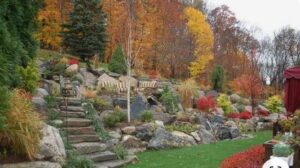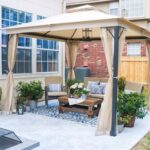Designing a garden on a slope requires planning and solutions, like terracing and choosing the right plants. Each aspect is important for making a functional and nice-looking outdoor space.
By using different design elements, you can deal with the slope’s challenges and improve how your garden looks and works.
Get creative with your sloped landscape to turn it into a beautiful outdoor sanctuary.
Key Takeaways
- Terracing and retaining walls prevent erosion and create flat planting areas.
- Steps, pathways, and staircases ensure safety and accessibility on sloped terrain.
- Plants with deep roots and groundcovers help stabilize slopes.
- Water features and greenery improve the look and attract more wildlife.
- Vertical gardening and native plants make gardens more interesting and easier to maintain.
Terracing for Sloped Gardens
To make a sloped garden more usable and attractive, consider building terraces with low walls. Terracing creates flat areas on a slope where you can do different things. You can plant flowers, put in seating areas, make patios, or even add small water features on each level.
Terraced gardens help manage water, stop soil from washing away, and give you space for gardening. They make your garden look interesting and easy to enjoy. By planning well and building terraces, you can make the most of your sloped garden.
Retaining Walls for Erosion Control
To control erosion and create level planting areas in a sloped garden, use retaining walls. Retaining walls help prevent soil erosion on steep slopes by holding the soil in place and reducing runoff. They also provide flat areas for planting, improve drainage, and support healthy plant growth.
When building retaining walls for erosion control, choose materials like COR-TEN steel, natural stone, or recycled materials for durability and a nice look. These walls not only serve a practical purpose but also enhance the garden’s overall appearance. To soften their appearance, plant cascading plants along the walls. These plants add a natural touch to the landscape and blend the walls seamlessly into the garden.
Steps and Pathways for Accessibility
When designing steps and pathways for accessibility in your sloped garden, consider using ramps, railings, and non-slip surfaces.
Ensure steps are evenly spaced and have a proper handrail for safety.
A practical guide will be provided to help you improve accessibility in your garden.
Sloped Path Options
Make your sloped garden easier to navigate and more beautiful by adding pathways and steps. Curving stairways can connect different levels smoothly, making it easier to move around and adding a nice touch to the look of your garden.
Using plants that can handle dry conditions on the steps helps prevent erosion and brings some greenery to the area, mixing function with beauty. Think about planting succulents along the pathways; these easy-to-care-for plants do well in hot weather and can add some color and texture to your sloped garden.
Step Design Considerations
When making steps on steep slopes, focus on creating wide and gentle steps. Include handrails for support, and use non-slip materials like rough stone or concrete for better grip. Make sure to have proper drainage to avoid water pooling on steps.
Consider adding lights for better visibility, especially at night. Plant flowers or shrubs alongside the steps for a beautiful touch. Be creative and add unique features to make your steps stand out.
Accessibility Features Guide
To make the garden wheelchair accessible, add gently sloping ramps next to stairs. Tips for a more inclusive garden:
- Pathway Width: Make pathways at least 36 inches wide for easy movement with wheelchairs.
- Non-Slip Surfaces: Use materials like textured pavers or gravel to prevent slipping.
- Safety Measures: Install handrails on stairs and pathways for support and include seating areas for resting.
Plant Selection for Slope Conditions
When planting on slopes, choose plants with deep roots, like yarrow and penstemon, to hold the soil in place.
Use creeping juniper and woolly thyme as groundcovers to stop erosion effectively.
Native plants like California lilac and manzanita are low-maintenance options that do well on slopes.
Soil Erosion Prevention
Choose plants with deep roots, like prairie dropseed and switchgrass, to keep soil in place on sloped gardens. For effective erosion prevention, consider the following:
- Creeping Junipers: These low plants stop erosion and look nice on your sloped garden.
- Woolly Thyme is another good groundcover plant that controls erosion and adds beauty to your landscape.
- Butterfly Bush and Daylilies: These plants do well in different sunlight levels on slopes, providing stability and beauty.
Low-Maintenance Ground Covers
For slopes, use plants like creeping thyme, periwinkle, ajuga, sedum, and vinca minor. They prevent erosion and need little care. Weed and prune them occasionally. Add organic matter to the soil for good drainage. Space plants properly for full coverage.
Japanese pachysandra and creeping juniper are drought-resistant options. Wintercreeper and bearberry offer year-round color with minimal maintenance. Bugleweed and lamb’s ear create a lush carpet effect on slopes.
Native Plant Species
For a strong and easy-to-care-for sloped garden, consider using local plant types that are used to the weather and soil in your area. These plants need less upkeep and can handle tough conditions.
When picking plants for your sloped garden, think about these things:
- Plants that don’t need a lot of water: Choose plants like California lilac that can survive with less watering, which is great for dry slopes.
- Plants that like shade: Pick plants like manzanita that thrive in spots with less sunlight, common on slopes.
- Plants that attract pollinators: Include plants like ceanothus that bring in butterflies and birds, adding more variety to your garden.
Maximizing Space With Terraces
When designing your sloped garden, think about using terraces to create flat areas at different levels. Terraces help maximize space and make it easier to plant, relax, and socialize in your garden.
They also prevent soil erosion and manage water runoff on steep slopes. Terraces add visual interest and dimension to your garden, allowing you to plant a variety of groundcovers, shrubs, and trees.
Incorporating Water Features
When adding water features to your sloped garden, consider creating cascading waterfalls for a beautiful look.
You can place ponds strategically and include streams to improve the overall feel of your outdoor space.
These features can turn your tricky terrain into a peaceful focal point in your garden.
Cascading Waterfall Design
Cascading waterfalls can enhance your sloped garden by adding beauty and a calming atmosphere. Here’s how to make the most of them:
- Lighting: Use lights to make your waterfall look beautiful at night.
- Sound: The sound of water flowing can create a relaxing feel in your garden.
- Maintenance: Keep your water pumps clean and make sure the water is flowing well for a long-lasting waterfall experience.
Pond Placement Options
If you want to make your sloped garden more beautiful with water features, think about where to put the pond to make it look nice and peaceful.
When adding ponds to sloped areas, it’s important to design the edges nicely, mix the water feature with the surroundings, and deal with the challenges of landscaping on a slope.
Making the pond edges look natural helps blend it into the landscape. Mixing the water feature with rocks and plants makes everything look like it belongs together.
Dealing with slope challenges means planning carefully to stop soil from washing away and to make sure the water flows right. By thinking about these things, you can create a lovely pond that adds to the beauty and calmness of your sloped garden.
Stream Integration Ideas
Consider adding a meandering stream to your sloped garden. Here are some ways to enhance your garden with water features:
- Seating by the stream: Place benches or chairs near the water for a relaxing spot.
- Light up the waterfall: Add subtle lighting to showcase the flowing water at night.
- Use natural stones: Line the stream with natural stones for a more natural look and feel in your garden design.
Utilizing Container Planting
Container planting is great for sloped gardens. Put pots strategically in busy areas for a big impact. Try different container combos and vertical gardening tricks. Use cool planter designs, like hanging baskets or tiered planters, for a neat look.
Mix up container sizes and plant types for a dynamic garden. Use tall containers to add height and maximize space. Place containers on the edges of sloped beds to catch the eye and make your garden look awesome.
Container gardens can jazz up entrances, walkways, and other important spots in your sloped garden. Play around with plants and containers to find your style and make your space pop.
Designing Staircases for Slopes
When designing staircases for sloped gardens, several factors should be taken into consideration.
- Lighting: Install lights along the stairs for safety and a nice evening ambiance. Solar-powered lights are a good eco-friendly option.
- Materials: Use sturdy materials like stone, brick, or concrete for the steps to ensure they last long and are safe to walk on.
- Colors: Pick colors that go well with the garden surroundings. Earthy tones like browns and greens blend nicely, while brighter colors can make a bold statement.

Native Plants for Sloped Landscapes
Using native plants on sloped landscapes is a great idea. Native plants are perfect for slopes because they’re well-suited to the local environment and need less upkeep than exotic plants. They attract birds and butterflies, promote biodiversity, and have deep roots that prevent soil erosion on steep slopes.
You can divide your sloped garden into different sections with native plants. For instance, you can have a rain garden with plants that like moist conditions, a rock garden with plants that can handle rocky terrain, or a wildflower meadow with colorful blooms that attract pollinators. These choices not only make your garden look nice but also help it thrive in tough conditions.
Enhancing Aesthetics With Greenery
If you have a sloped garden and want to make it look better, here are some ideas:
- Use trellises and green walls to grow plants vertically.
- Choose succulents and plants that don’t need a lot of water.
- Plant flowers and shrubs that bloom at different times of the year for a colorful garden all year round.
Frequently Asked Questions
How to Cheaply Landscape a Steep Hill?
If you want to landscape a steep hill on a budget, you can create terraces using inexpensive materials. Plant groundcover to prevent erosion and make it look nice. Add steps for easy access, and use plants that can survive with little water. Be creative with your plant choices!
What Can I Do With a Slanted Garden?
For your slanted garden, use terraced planters to display different plants, create winding pathways, and add raised seating areas for relaxing and enjoying the view.
How Can I Make My Sloped Yard Look Good?
Consider terrace gardening to make your sloped yard look good. Choose plants that thrive at various levels. Use retaining walls for both function and beauty. These solutions can transform your challenging terrain.
How Do You Level Up a Sloping Garden?
To level up a sloping garden, build retaining walls and terraced gardens for support. Make sure to grade the land properly and set up drainage systems. Pick plants that do well on slopes and use ground cover to stop erosion.
Conclusion
In conclusion, designing a sloped garden requires planning and solutions like terracing, retaining walls, steps, pathways, and suitable plants. These elements help create a beautiful and functional outdoor space that looks good and is sustainable.
Make sure to think about accessibility, erosion control, and plant selection to maximize your sloped garden’s potential. With these design choices, you can turn challenging terrain into a stunning and practical landscape.











